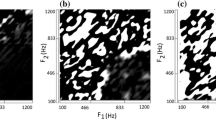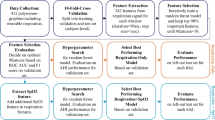Abstract
Previous work has identified that non-linear variables calculated from respiratory data vary between sleep states, and that variables derived from the non-linear analytical tool recurrence quantification analysis (RQA) are accurate infant sleep state discriminators. This study aims to apply these discriminators to automatically classify 30 s epochs of infant sleep as REM, non-REM and wake. Polysomnograms were obtained from 25 healthy infants at 2 weeks, 3, 6 and 12 months of age, and manually sleep staged as wake, REM and non-REM. Inter-breath interval data were extracted from the respiratory inductive plethysmograph, and RQA applied to calculate radius, determinism and laminarity. Time-series statistic and spectral analysis variables were also calculated. A nested cross-validation method was used to identify the optimal feature subset, and to train and evaluate a linear discriminant analysis-based classifier. The RQA features radius and laminarity and were reliably selected. Mean agreement was 79.7, 84.9, 84.0 and 79.2 % at 2 weeks, 3, 6 and 12 months, and the classifier performed better than a comparison classifier not including RQA variables. The performance of this sleep-staging tool compares favourably with inter-human agreement rates, and improves upon previous systems using only respiratory data. Applications include diagnostic screening and population-based sleep research.




Similar content being viewed by others
References
Anders T, Emde R, Parmalee A (eds) (1971) A manual of standardized terminology, techniques and criteria for scoring states of sleep and wakefulness in newborn infants. UCLA Brain Information Service, Los Angeles
Bolton DP, Herman S (1974) Ventilation and sleep state in the new-born. J Physiol 240(1):67–77
Brooks LJ, DiFiore JM, Martin RJ, CHIME Study Group (1997) Assessment of tidal volume over time in preterm infants using respiratory inductance plethysmography. Pediatr Pulmonol 23(6):429–433
Burioka N, Cornelissen G, Halberg F, Kaplan DT, Suyama H, Sako T, Shimizu E (2003) Approximate entropy of human respiratory movement during eye closed waking and different sleep stages. Chest 123(1):80–86
Chervin RD, Burns JW (2011) Engineering better sleep. Med Biol Eng Comput 49(6):623–625
Cohen J (1960) A coefficient of agreement for nominal scales. Educ Phsychol Meas 20(37):37–47
Crowell DH, Brooks LJ, Colton T, Corwin MJ, Hoppenbrouwers T, Hunt CE, Kapuniai LE, Lister G, Neuman MR, Peucker M, Ward SL, Weese-Mayer DE, Willinger M, CHIME Study Group (1997) Infant polysomnography: reliability. Sleep 20:553–560
Curzi-Dascalova L, Gaudebout C, Dreyfus-Brisac C (1981) Respiratory frequencies of sleeping infants during the first months of life: correlations between values in different sleep states. Early Hum Dev 5(1):39–54
Duffin J (1990) The chemoreflex control of breathing and its measurement. Can J Anaesth 37(8):933–942
Durr P, Karlen W, Guignard J, Mattiussi C, Floreano D (2009) Evolutionary selection of features for neural sleep/wake discrimination. J Artif Evol Appl 2009:1–9
Eckmann JP, Kamphorst SO, Ruelle D (1987) Recurrence plots of dynamical systems. Europhys Lett 4(9):973–977
Estevez PA, Held CM, Holzmann CA, Perez CA, Perez JP, Heiss J, Garrido M, Peirano P (2002) Polysomnographic pattern recognition for automated classification of sleep–waking states in infants. Med Biol Eng Comput 40(1):105–113
Euler CV, Fernando H, Wexler I (1970) Control mechanisms determining the rate and depth of respiratory movements. Respir Physiol 10(1):93–108
Fitzgerald DA, Massie RJ, Nixon GM, Jaffe A, Wilson A, Landau LI, Twiss J, Smith G, Wainwright C, Harris M (2008) Infants with chronic neonatal lung disease: recommendations for the use of home oxygen therapy. Med J Aust 189(10):578–582
Grigg-Damberger M, Gozal D, Marcus CL, Quan SF, Rosen CL, Chervin RD, Wise M, Picchietti DL, Sheldon SH, Iber C (2007) The visual scoring of sleep and arousals in infants and children. J Clin Sleep Med 3(2):201–243
Grodins FS, Buell J, Bart AJ (1967) Mathematical analysis and digital simulation of the respiratory control system. J Appl Physiol 22(2):260–276
Haddad GG, Jeng HJ, Lai TL, Mellins RB (1987) Determination of sleep state in infants using respiratory variability. Pediatr Res 21(6):556–562
Harper RM, Schechtman VL, Kluge KA (1987) Machine classification of infant sleep state using cardiorespiratory measures. Electroencephalogr Clin Neurophysiol 67:379–387
Heiss JE, Held CM, Estevez PA, Perez CA, Holzmann CA, Perez JP (2002) Classification of sleep stages in infants: a neuro fuzzy approach. IEEE Eng Med Biol Mag 21(5):147–151
Held CM, Heiss JE, Estevez PA, Perez CA, Garrido M, Algarin C, Peirano P (2006) Extracting fuzzy rules from polysomnographic recordings for infant sleep classification. IEEE Trans Biomed Eng 53(10):1954–1962
Holzmann CA, Perez CA, Held CM, San Martin M, Pizarro F, Perez JP, Garrido M, Peirano P (1999) Expert-system classification of sleep/waking states in infants. Med Biol Eng Comput 37(4):466–476
Jain AK, Duin RPW, Mao J (2000) Statistical pattern recognition: a review. IEEE Trans Pattern Anal Mach Intell 22(1):4–37
Karlen W, Mattiussi C, Floreano D (2008) Improving actigraph sleep/wake classification with cardio-respiratory signals. In: Conference proceedings of the 30th annual conference of the IEEE engineering in medicine and biology society, pp 5262–5265
Krzanowski WJ (1988) Principles of multivariate analysis: a user's perspective. Oxford University Press, New York
Martin J, Hiscock H, Hardy P, Davey B, Wake M (2007) Adverse associations of infant and child sleep problems and parent health: an Australian population study. Pediatrics 119(5):947–955
Marwan N, Romano MC, Thiel M, Kurths J (2007) Recurrence plots for the analysis of complex systems. Phys Rep 438:237–329
Mendez MO, Matteucci M, Cerutti S, Bianchi AM, Kortelainen JM (2009) Automatic detection of sleep macrostructure based on bed sensors. In: Conference proceedings of the 31st annual conference of the IEEE engineering in medicine and biology society, pp 5555–5558
Morgenthaler T, Alessi C, Friedman L, Owens J, Kapur V, Boehlecke B, Brown T, Chesson A, Coleman J, Lee-Chiong T, Pancer J, Swick TJ (2007) Practice parameters for the use of actigraphy in the assessment of sleep and sleep disorders: an update for 2007. Sleep 30(4):519–529
Patzak A, Schluter B, Mrowka R, Unbehaun A, Gerhardt D, Persson PB, Barschdorff D, Trowitzsch E (1999) Rhythms and complexity of respiration during sleep in pre-term infants. Clin Physiol 19(6):458–466
Penzel T, Hirshowitz M, Harsh J, Chervin RD, Butkov N, Kryger M, Malow B, Vitello MV, Silber MH, Kushida CA, Chesson AL (2007) Digital analysis and technical specifications. J Clin Sleep Med 3(2):109–120
Pilgram B, Schappacher W, Loscher WN, Pfurtscheller G (1995) Application of the correlation integral to respiratory data of infants during REM sleep. Biol Cybern 72(6):543–551
Pudil P, Novovicova J, Kittler J (1994) Floating search methods in feature selection. Pattern Recognit Lett 15(11):1119–1125
Redmond SJ, Heneghan C (2006) Cardiorespiratory-based sleep staging in subjects with obstructive sleep apnea. IEEE Trans Biomed Eng 53(3):485–496
Sazonova NA, Sazonov EE, Tan B, Schuckers SAC, CHIME Study Group (2006) Sleep state scoring in infants from respiratory and activity measurements. In: Conference proceedings of the 28th annual conference of the IEEE engineering in medicine and biology society, pp 2462–2465
Schmidt M, Foitzik B, Wauer RR, Winkler F, Schmalisch G (1998) Comparative investigations of algorithms for the detection of breaths in newborns with disturbed respiratory signals. Comput Biomed Res 31(6):413–425
Small M, Judd K, Lowe M, Stick S (1999) Is breathing in infants chaotic? Dimension estimates for respiratory patterns during quiet sleep. J Appl Physiol 86(1):359–376
Spicuzza L, Leonardi S, La Rosa M (2008) Pediatric sleep apnea: early onset of the ‘syndrome’? Sleep Med Rev 13(2):111–122
Takens F, Rand DA, Young LS (1981) Detecting strange attractors in turbulence. In: Rand DA, Young LS (eds) Dynamical systems and turbulence, Lecture Notes in Mathematics vol 898, pp 366–381
Terrill PI, Wilson SJ, Suresh S, Cooper DM (2009) Characterising infant inter-breath interval patterns during active and quiet sleep using recurrence plot analysis. In: Conference proceedings of the 31st annual conference of the IEEE engineering in medicine and biology society, pp 6284–6287
Terrill PI, Wilson SJ, Suresh S, Cooper DM, Dakin CJ (2010) Attractor structure discriminates sleep states: recurrence plot analysis applied to infant breathing patterns. IEEE Trans Biomed Eng 57(5):1108–1116
Terrill PI, Suresh S, Wilson SJ, Cooper DM (2011) Evaluation of a commercially available automated sleep staging tool in healthy infants. Sleep Biol Rhythms 9(2):112–116
van Houdt PJ, Ossenblok PPW, van Erp MG, Schreuder KE, Krijn RJJ, Boon PAJM, Cluitmans PJM (2011) Automatic breath-to-breath analysis of nocturnal polysomnographic recordings. Med Biol Eng Comput 49(7):819–830
Varma S, Simon R (2006) Bias in error estimation when using cross-validation for model selection. BMC Bioinform 7(91)
Webber CL Jr, Zbilut JP (1994) Dynamical assessment of physiological systems and states using recurrence plot strategies. J Appl Physiol 76(2):965–973
Welch P (1967) The use of fast fourier transform for the estimation of power spectra: a method based on time averaging over short, modified periodograms. IEEE Trans Audio Electroacoust 5(2):70–73
Wysocki M, Fiamma MN, Straus C, Poon CS, Similowski T (2006) Chaotic dynamics of resting ventilatory flow in humans assessed through noise titration. Respir Physiol Neurobiol 153(1):54–65
Yamashiro SM (2007) Non-linear dynamics of human periodic breathing and implications for sleep apnoea therapy. Med Biol Eng Comput 45(4):345–356
Acknowledgments
We would like to acknowledge the infants and families who participated in the study and the staff at the Mater Children’s Hospital for their dedicated work in collecting the infant sleep study data analysed in this study. The data collection for this research was supported by a grant from the Mater Children’s Hospital Golden Casket Research Fund.
Author information
Authors and Affiliations
Corresponding author
Rights and permissions
About this article
Cite this article
Terrill, P.I., Wilson, S.J., Suresh, S. et al. Application of recurrence quantification analysis to automatically estimate infant sleep states using a single channel of respiratory data. Med Biol Eng Comput 50, 851–865 (2012). https://doi.org/10.1007/s11517-012-0918-4
Received:
Accepted:
Published:
Issue Date:
DOI: https://doi.org/10.1007/s11517-012-0918-4




